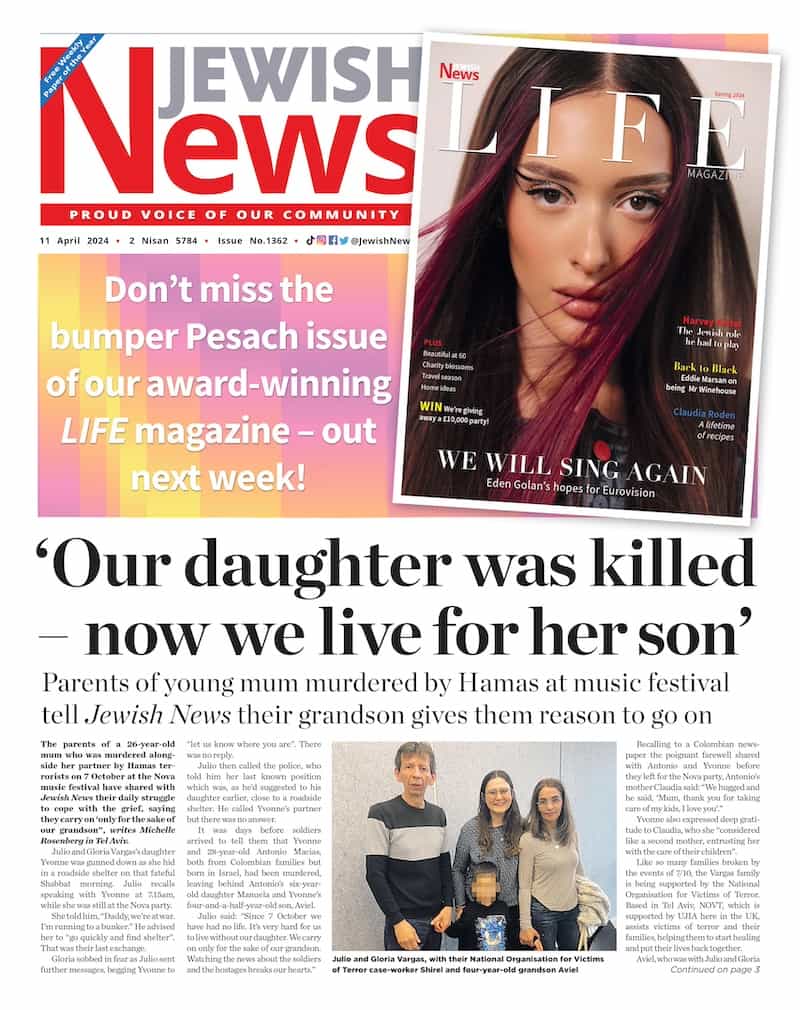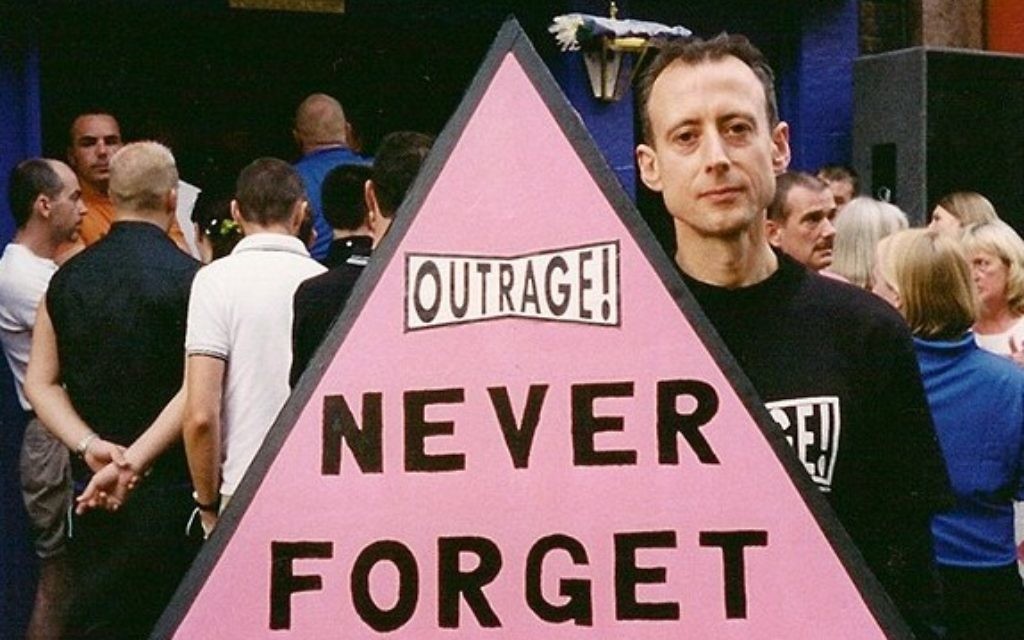Peter Tatchell: The Nazi war on gay people
By Peter Tatchell 
In the early 1930s, Berlin was the gay capital of the world, with a huge, buzzing gay scene of bars and clubs. It boasted gay magazines and gay arts and sports associations, as well as organisations campaigning for greater understanding and rights. Life in Berlin was good – and getting better – for lesbian, gay, bisexual and transgender (LGBT) people.
Although homosexuality was illegal under paragraph 175 of the German criminal code, it was rarely enforced. In the Reichstag, MPs were on the verge of securing its repeal. A new era of freedom seemed to be dawning.
Get The Jewish News Daily Edition by email and never miss our top stories Free Sign Up
Then came Nazism.
Within weeks of assuming power in 1933, Hitler outlawed homosexual organisations and publications. Gay bars and clubs were closed down soon afterwards. Storm troopers ransacked the headquarters of the gay rights movement, the Institute of Sexual Science, and publicly burned its vast library of “degenerate” books. Before the end of the year, the first homosexuals were deported to newly established concentration camps.
Some of the personal stories of gay survivors were told in the film, Paragraph 175.
Gad Beck was one of them.
In the 1930s, he was a precociously gay Jewish schoolboy, sweetly innocent about homophobia.
He recalls: “I had an athletics teacher … One day we were showering together and I jumped on him. I ran home to my mother and said: ‘Mother, today I had my first man.'” Luckily, his parents accepted his homosexuality. But they feared for his future. He remembers their reaction: “They said: ‘Oh my god, he’s Jewish and he’s gay. Either way he’ll be persecuted. This cannot end well.'”
But Beck survived the war, although nearly everyone around him perished. Two of his lovers were seized by the Nazis. “I met this beautiful blonde Jew. He invited me to spend the night. In the morning the Gestapo came … I showed my ID – not on the list. They took him to Auschwitz. It had a different value then, a night of love.”
Later, Beck tried to free another lover, Manfred, from a Gestapo transfer camp by posing as a Hitler Youth member. This incredibly dangerous deception was successful, but as they walked to freedom, Manfred told Gad he could not abandon his family in the camp.
Beck watched helplessly as his lover returned to be with them. He never saw Manfred again.
In 1934, the Nazis stepped up their anti-gay campaign, with the creation of the Reich Office for Combating Abortion and Homosexuality.
According to Himmler: “Those who practice homosexuality deprive Germany of the children they owe her … our nation will fall to pieces because of that plague.” The police were ordered to draw up “pink lists” of known or suspected homosexuals.
Mass arrests followed.
At the age of 17 in Nazi-occupied France, Frenchman Pierre Seel was incarcerated by the Germans after they seized local police files on homosexuals. “They saw our names on these lists”, he says. “I ended up at the camp in Schirmeck.”
“There was a hierarchy from weakest to strongest. The weakest in the camps were the homosexuals. All the way at the bottom…I was tortured, beaten…sodomised and raped. The Nazis stuck 25cm of wood up my arse … (it) still bleeds, even today.”
Seel’s lover Jo suffered a worse fate. “He was condemned to die, eaten by dogs. German dogs! German Shepherds!”, Seel shouts with rage. “That I can never forget.”
The Nazis again intensified the war against what they called “abnormal existence” in 1935, broadening the definition of homosexual behaviour and the grounds for arrest. Gossip and innuendo became evidence. A man could be incarcerated on the basis of a mere touch, gesture or look.
Later, Himmler authorised a scientific programme for the eradication of “this vice.”
Gay prisoners were subjected to gruesome medical experiments in a bid to “cure” their homossexuality – including hormone implants and castration.
From 1933-1945, around 50,000 to 100,000 men were arrested under Paragraph 175 for the crime of homosexuality. Some were sent to prisons; others direct to concentration camps without any trial or formal sentence. The death rate of gay prisoners in the camps was over 50 per cent, the highest among non-Jewish victims.
Heinz Dormer spent nearly ten years in prisons and concentration camps. He remembers the haunting, agonised cries from “the singing forest”, a row of tall poles on which condemned men were hung: “Everyone who was sentenced to death would be lifted up onto the hook. The howling and screaming were inhuman…Beyond human comprehension.”

The Nazi “homocaust” sought to completely eliminate gay and bisexual men. It was an integral part of the Holocaust. Contrary to false histories that claim the persecution of Jewish people was entirely distinct and separate from the victimisation of other minorities, the mass murder of Jews was part of Hitler’s grand design for the racial purification of the German volk. The Nazis set out to eradicate what they deemed to be racial and genetic “inferiors” – not just Jews, but also gay, disabled, Slav, Roma and Sinti people.
Even after the Nazi defeat in 1945, gay survivors continued to be persecuted. Men liberated from the concentration camps who had not completed their sentences were re-imprisoned by the victorious Allied administration to serve the rest of their time.
Since they were regarded as common criminals, all were denied compensation for their suffering. Indeed, successive German governments refused to pay reparations to the gay victims for four decades – and then only after a public campaign and after most gay survivors had died.
As a further insult, the former SS guards were awarded better pensions than their gay prisoners.
The guard’s work in the concentration camps counted toward their pension entitlement, whereas the time spent in the camps by gay inmates did not.
Many Nazi doctors, including those who experimented on gay prisoners, were never put on trial at Nuremburg. The most notorious of all was Dr Carl Vaernet.
Tasked by Himmler to secure a means to eliminate homosexuality, he conducted grisly experiments on gay prisoners in Buchenwald and Neuengamme concentration camps. After the war he was arrested and detained in a prisoner-of-war camp in Copenhagen. But amazingly he was allowed by the British military authorities and the Danish government to escape to Argentina in 1946, where he lived freely until his death in 1965.
Paragraph 175 remained in force in Germany until 1969.
Some gay Holocaust survivors, such as Heinz Dormer, were re-arrested in the post-war period and again jailed.
In the 1950s and 1960s, the number of convictions for homosexuality in West Germany was as high as it had been during Nazi rule.
Peter will be lighting a candle and reading at Monday’s Holocaust Memorial Day service and concert at West London Synagogue (flyer below) which also includes guests from other communities including from Congo, Kurdish as well as Jewish
For more information about Peter Tatchell’s human rights campaigns, to receive his email bulletins or to make a donation: www.PeterTatchellFoundation.org


Thank you for helping to make Jewish News the leading source of news and opinion for the UK Jewish community. Today we're asking for your invaluable help to continue putting our community first in everything we do.
For as little as £5 a month you can help sustain the vital work we do in celebrating and standing up for Jewish life in Britain.
Jewish News holds our community together and keeps us connected. Like a synagogue, it’s where people turn to feel part of something bigger. It also proudly shows the rest of Britain the vibrancy and rich culture of modern Jewish life.
You can make a quick and easy one-off or monthly contribution of £5, £10, £20 or any other sum you’re comfortable with.
100% of your donation will help us continue celebrating our community, in all its dynamic diversity...
Engaging
Being a community platform means so much more than producing a newspaper and website. One of our proudest roles is media partnering with our invaluable charities to amplify the outstanding work they do to help us all.
Celebrating
There’s no shortage of oys in the world but Jewish News takes every opportunity to celebrate the joys too, through projects like Night of Heroes, 40 Under 40 and other compelling countdowns that make the community kvell with pride.
Pioneering
In the first collaboration between media outlets from different faiths, Jewish News worked with British Muslim TV and Church Times to produce a list of young activists leading the way on interfaith understanding.
Campaigning
Royal Mail issued a stamp honouring Holocaust hero Sir Nicholas Winton after a Jewish News campaign attracted more than 100,000 backers. Jewish Newsalso produces special editions of the paper highlighting pressing issues including mental health and Holocaust remembrance.
Easy access
In an age when news is readily accessible, Jewish News provides high-quality content free online and offline, removing any financial barriers to connecting people.
Voice of our community to wider society
The Jewish News team regularly appears on TV, radio and on the pages of the national press to comment on stories about the Jewish community. Easy access to the paper on the streets of London also means Jewish News provides an invaluable window into the community for the country at large.
We hope you agree all this is worth preserving.
-
By Laurent Vaughan - Senior Associate (Bishop & Sewell Solicitors)
-
By Laurent Vaughan - Senior Associate (Bishop & Sewell Solicitors)
-
By Laurent Vaughan - Senior Associate (Bishop & Sewell Solicitors)
-
By Laurent Vaughan - Senior Associate (Bishop & Sewell Solicitors)






















